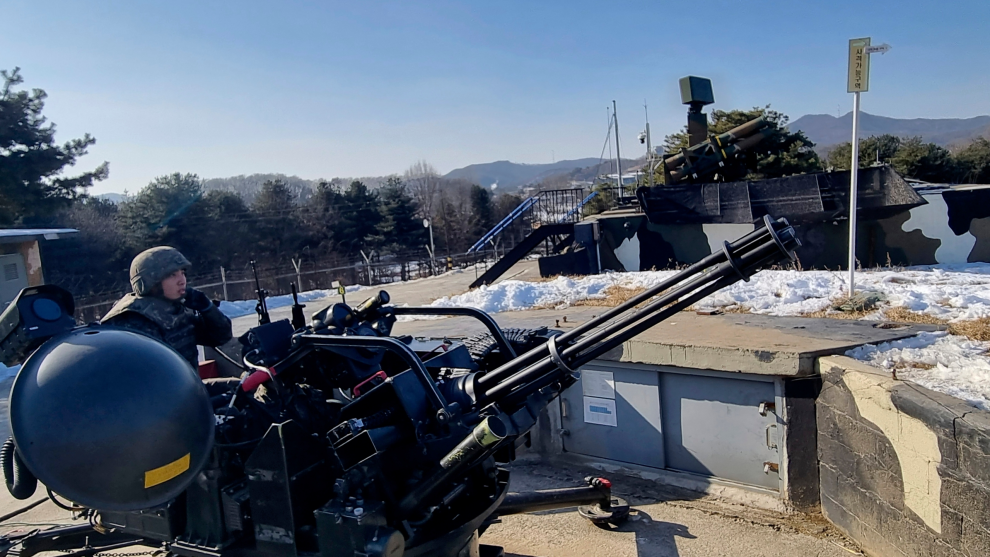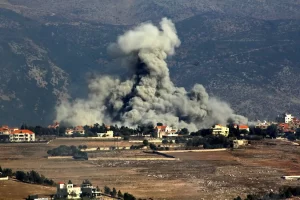SEOUL, SOUTH KOREA — In June, after North Korea fired eight short-range ballistic missiles into the ocean, South Korea and the United States responded by sending the exact same number of missiles into the sea.
Five months later, when a North Korean missile crossed the de facto inter-Korean sea border for the first time since the 1950s Korean War, South Korea hours later launched three of its own missiles north of the sensitive maritime boundary.
Last week, after North Korea sent five small reconnaissance drones across the land border, South Korea quickly retaliated by sending one of its own drones into the North for the first time and vowed to send two or three more for every future North Korean drone incursion.
Under President Yoon Suk Yeol, South Korea has adopted an explicit “tit for tat” policy when responding to North Korean aggression.
Supporters say such an approach helps keep the peace. By responding with quick, corresponding displays of force, South Korea and the United States can demonstrate their ability and willingness to respond using superior weapons, they argue.
But critics say the strategy also increases the likelihood of misunderstandings or mistakes, leading to a situation that could quickly escalate. In addition, it ensures North Korea is in the driver’s seat, they say, by allowing it to more easily start provocation cycles that could be exploited.
Approach not new
The South Korean military has long defended responding to North Korea’s threatening actions with at least proportional measures, and sometimes more.
During periods of military tensions, South Korea has often embraced a policy of retaliating with at least three times as much force as North Korea. The “three-to-one” policy stretches back at least to 2010, when South Korea responded to North Korea’s deadly shelling of the frontline island of Yeonpyeong.
The policy has again become more clear-cut over the last few years, as North Korea ramps up its weapons tests and threats after having mostly paused such actions during its 2018-19 outreach to Washington and Seoul.
The near-constant North Korean missile tests have prompted South Korea to not only push for bigger displays of military force on its own, but also in coordination with its ally, the United States.
Debate over how best to respond, and what role South Korea should play, has at times created friction between the two allies – such as earlier this week, when Washington publicly dismissed Yoon’s idea of holding joint nuclear exercises with Seoul.
Many risks
Although South Korea needs to show resolve in the face of North Korean provocations, the country’s tit-for-tat reactions are worrisome, according to Chun In-bum, a retired lieutenant general in the South Korean army.
“A million things can go wrong – just think about it,” Chun said in an interview with VOA.
Among the possibilities, according to Chun, are that Yoon’s orders could be misinterpreted by an overeager South Korean military leader, North Korea could confuse South Korea’s retaliation with an attack and fire on the South, South Korean weapons could malfunction, as they did on multiple occasions during such responses last year, and advanced South Korean weapons, such as drones, could be captured by the North if sent across the border.
No ‘payback’ allowed
South Korea’s responses have also at times violated the Armistice Agreement, which is meant to prevent the resumption of hostilities following the 1950-53 Korean War.
Yoon’s “three-for-one” drone threat may be particularly problematic on that front, Chun said.
Under the terms of the armistice, cross-border military responses are only allowed if they are proportional and in self-defense, according to Chun.
On the one hand, South Korean authorities would be justified in shooting down North Korean drones on South Korean territory, he said, adding there are many instances where even an unarmed drone could be seen as life-threatening.
On the other hand, sending drones north of the border as a sort of “payback,” as proposed by Yoon, would violate armistice rules of engagement, Chun said.
United Nations Command, the multinational military force charged with upholding the armistice, has not commented other than to say it launched an investigation following the North Korean drone incursion. When contacted by VOA, U.N. Command did not say whether it will also investigate South Korea’s actions. But following past border skirmishes, U.N. Command has faulted both sides.
Following a May 2020 exchange of gunfire at guard posts within the Demilitarized Zone, the U.N. Command found that both North and South Korea committed armistice violations.The investigation found North Korea violated the armistice when it fired four rounds of ammunition at a South Korean guard post, possibly by accident. South Korean guards, who waited 32 minutes before responding with two volleys of gunfire, also committed violations, according to U.N. Command.
Deterrence considerations
Despite the escalatory risks, South Korea’s firm response strategy has many supporters.Dan Pinkston, a Seoul-based international relations professor at Troy University, argues there would be a bigger risk in appearing intimidated by North Korea’s threats. Proportional retaliation, he says, ensures North Korea knows it will be defeated if it attacks the South.
Pinkston shrugs off the idea that such an approach may invite further North Korean weapons tests, which he says are often preplanned exercises meant to develop particular weapons systems.
“It’s part of an ongoing program … you can’t really ‘deter’ exercises,” Pinkston said.
As for the escalatory risks, Pinkston said the two Koreas are currently “a long way” from major hostilities and that off-ramps would be available if tensions should approach that point.
Alliance coordination
If North Korea keeps provoking the South – while continuing to build more and better weapons – South Korea may feel it must continue its high-stakes retaliation. Yoon, a former prosecutor with no prior political experience, may also keep responding in ways that risk escalating tensions.
Following nearly every North Korean provocation, U.S. and South Korean officials reiterate they are in close contact – a crucial factor moving forward, analysts say.
“It only reinforces the need for continued air-tight alliance coordination on provocation response … and public messaging,” said Robert Rapson, charge d’affaires and deputy chief of mission at the U.S. embassy in Seoul until 2021.
“There’s no room for any perception in the North of cracks in bilateral unity of purpose and approach to Pyongyang’s challenges,” Rapson told VOA. “The consequences of miscalculation are too great.”
Source: Voice of America






































